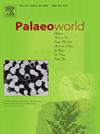First late Silurian (Ludfordian–Pridoli?) brachiopods from Iran
IF 1.7
3区 地球科学
Q2 PALEONTOLOGY
引用次数: 0
Abstract
Ludlow to Pridoli? rhynchonellate brachiopods, previously unknown in Iran, are described from the upper Dahaneh-Kalut Formation, outcropping in the Derenjal Mountains on the northern margin of the East-Central Iranian platform. The brachiopod faunas comprise eight species assigned to eight genera including Ancillotoechia bicostata n. sp., Isorthis (Ovalella) equimulticostellata n. sp., Protathyris golshanensis n. sp., and Macropleura kuhestanensis n. sp. The Ludfordian age of these taxa is supported by the occurrences of the conodonts Ozarkodina crispa (Walliser) and Ozarkodina sp. cf. O. snajdri (Walliser). Three low richness and high abundance brachiopod communities are recognised, all of which inhabited a shallow-water carbonate shelf within the Benthic Assemblages 2 and 3. Despite the prevalence of cosmopolitan genera, the Iranian Ludfordian–Pridoli? brachiopod faunas show little interaction with geographically closest contemporaneous faunas of the Australian sector of Gondwana and South China plate.
第一批来自伊朗的晚志留世(卢德福-普里多利?)腕足动物
勒德洛到普里多利?以前在伊朗不为人知的颈足类腕足动物,被描述为在伊朗中东部地台北缘的德伦哈尔山脉的上Dahaneh-Kalut组。腕足动物包括8属8种,包括Ancillotoechia bicostata n. sp.、Isorthis (Ovalella) equimulticostellata n. sp.、Protathyris golshanensis n. sp.和Macropleura kuhestanensis n. sp.。这些分类群的Ludfordian年龄得到了牙形刺Ozarkodina crispa (Walliser)和Ozarkodina sp. cf. O. snajdri (Walliser)的存在的支持。发现了3个低丰度和高丰度的腕足动物群落,它们都生活在底栖组合2和底栖组合3的浅水碳酸盐陆架上。尽管世界性的属普遍存在,但伊朗的Ludfordian-Pridoli ?腕足类动物群与冈瓦纳和华南板块澳大利亚板块地理上最近的同时期动物群相互作用不大。
本文章由计算机程序翻译,如有差异,请以英文原文为准。
求助全文
约1分钟内获得全文
求助全文
来源期刊

Palaeoworld
PALEONTOLOGY-
CiteScore
4.00
自引率
5.90%
发文量
95
期刊介绍:
Palaeoworld is a peer-reviewed quarterly journal dedicated to the study of past life and its environment. We encourage submission of original manuscripts on all aspects of palaeontology and stratigraphy, comparisons of regional and global data in time and space, and results generated by interdisciplinary investigations in related fields. Some issues will be devoted entirely to a special theme whereas others will be composed of contributed articles. Palaeoworld is dedicated to serving a broad spectrum of geoscientists and palaeobiologists as well as serving as a resource for students in fields as diverse as palaeobiology, evolutionary biology, taxonomy and phylogeny, geobiology, historical geology, and palaeoenvironment.
Palaeoworld publishes original articles in the following areas:
•Phylogeny and taxonomic studies of all fossil groups
•Biostratigraphy, chemostratigraphy, chronostratigraphy
•Palaeoecology, palaeoenvironment and global changes throughout Earth history
•Tempo and mode of biological evolution
•Biological events in Earth history (e.g., extinctions, radiations)
•Ecosystem evolution
•Geobiology and molecular palaeobiology
•Palaeontological and stratigraphic methods
•Interdisciplinary studies focusing on fossils and strata
 求助内容:
求助内容: 应助结果提醒方式:
应助结果提醒方式:


